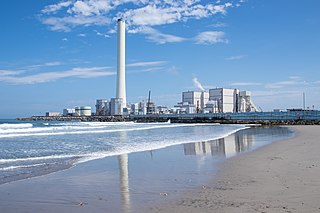Southern Company is an American gas and electric utility holding company based in the southern United States. It is headquartered in Atlanta, Georgia, with executive offices also located in Birmingham, Alabama. The company is the second largest utility company in the U.S. in terms of customer base, as of 2021. Through its subsidiaries it serves 9 million gas and electric utility customers in 6 states. Southern Company's regulated regional electric utilities serve a 120,000-square-mile (310,000 km2) territory with 27,000 miles (43,000 km) of distribution lines.
Puget Sound Energy (PSE) is an energy utility company based in the U.S. state of Washington that provides electrical power and natural gas to the Puget Sound region. The utility serves electricity to more than 1.1 million customers in Island, King, Kitsap, Kittitas, Pierce, Skagit, Thurston, and Whatcom counties, and provides natural gas to 750,000 customers in King, Kittitas, Lewis, Pierce, Snohomish and Thurston counties. The company's electric and natural gas service area spans 6,000 square miles (16,000 km2).

A fossil fuel power station is a thermal power station which burns a fossil fuel, such as coal or natural gas, to produce electricity. Fossil fuel power stations have machinery to convert the heat energy of combustion into mechanical energy, which then operates an electrical generator. The prime mover may be a steam turbine, a gas turbine or, in small plants, a reciprocating gas engine. All plants use the energy extracted from the expansion of a hot gas, either steam or combustion gases. Although different energy conversion methods exist, all thermal power station conversion methods have their efficiency limited by the Carnot efficiency and therefore produce waste heat.

Florida Power & Light Company (FPL), the principal subsidiary of NextEra Energy Inc., is the largest power utility in Florida. It is a Juno Beach, Florida-based power utility company serving roughly 5 million customers and 11 million people in Florida. It is a rate-regulated electric utility that generates, transmits, distributes and sells electric energy. In 2020, the company was ranked as the nation's most reliable electric power utility for the fifth time in six years.

Coal Pollution Mitigation, sometimes also known as Clean Coal, is a series of systems and technologies that seek to mitigate health and environmental impact of coal; in particular air pollution from coal-fired power stations, and from coal burnt by heavy industry. Clean Coal primarily focuses on removing sulfur dioxide (SO2) and nitrogen oxides (NOx), the most important gasses which cause acid rain; and particulates which cause visible air pollution, illness, and premature deaths. It also reduces fly ash and reduces emissions of radioactive materials. Mercury emissions can be reduced up to 95%. Capturing carbon dioxide emissions from coal is also being pursued.
An integrated gasification combined cycle (IGCC) is a technology using a high pressure gasifier to turn coal and other carbon based fuels into pressurized gas—synthesis gas (syngas). It can then remove impurities from the syngas prior to the electricity generation cycle. Some of these pollutants, such as sulfur, can be turned into re-usable byproducts through the Claus process. This results in lower emissions of sulfur dioxide, particulates, mercury, and in some cases carbon dioxide. With additional process equipment, a water-gas shift reaction can increase gasification efficiency and reduce carbon monoxide emissions by converting it to carbon dioxide. The resulting carbon dioxide from the shift reaction can be separated, compressed, and stored through sequestration. Excess heat from the primary combustion and syngas fired generation is then passed to a steam cycle, similar to a combined cycle gas turbine. This process results in improved thermodynamic efficiency, compared to conventional pulverized coal combustion.

The Robert W. Scherer Power Plant is a coal-fired power plant in Juliette, Georgia, just north of Macon, Georgia, in the United States. The plant has four generating units, each capable of producing 930 megawatts, and is the most powerful coal-fired plant in North America. The plant is named after the former chairman and chief executive officer of Georgia Power.

Mississippi Power is an investor-owned electric utility and a wholly owned subsidiary of Atlanta-based Southern Company. Mississippi Power Company (MPC) is headquartered in Gulfport, Mississippi.
The Westinghouse Combustion Turbine Systems Division (CTSD), part of Westinghouse Electric Corporation's Westinghouse Power Generation group, was originally located, along with the Steam Turbine Division (STD), in a major industrial manufacturing complex, referred to as the South Philadelphia Works, in Lester, Pennsylvania near to the Philadelphia International Airport.

Coal generated about 19.5% of the electricity at utility-scale facilities in the United States in 2022, down from 38.6% in 2014 and 51% in 2001. In 2021, coal supplied 9.5 quadrillion British thermal units (2,800 TWh) of primary energy to electric power plants, which made up 90% of coal's contribution to U.S. energy supply. Utilities buy more than 90% of the coal consumed in the United States. There were over 200 coal powered units across the United States in 2022. Coal plants have been closing since the 2010s due to cheaper and cleaner natural gas and renewables. But environmentalists say that political action is needed to close them faster, to reduce greenhouse gas emissions by the United States to better limit climate change.
Edwardsport Power Station is a 618 MW Integrated gasification combined cycle (IGCC) coal based power plant in Vigo Township, Knox County, near the town of Edwardsport, Indiana. The integrated gasification combined cycle power plant construction started in June 2008 by Duke Energy near the site of an older 160 MW coal-fired electrical power plant, which was decommissioned in 2010.
Martin Next Generation Solar Energy Center is the solar parabolic-trough component of an integrated solar combined cycle (ISCC) 1150 MW plant, in western Martin County, Florida, United States, just north of Indiantown. The project was built by Florida Power & Light Company (FPL). Lauren Engineers & Constructors (Abilene, TX) was the EPC contractor for the project. Its construction began in 2008 and was completed by the end of 2010.
The Kędzierzyn Zero-Emission Power and Chemical Complex was a proposed facility in Kędzierzyn-Koźle, Poland. It was planned to combine the functions of power and heat generation with chemical production and carbon capture and storage. The project was proposed by a consortium of chemicals producers, including Zakłady Azotowe Kędzierzyn and the electricity company Południowy Koncern Energetyczny. The facility would have produced synthesis gas by gasification of hard coal. Gas produced by the plant would have been used for power and heat generation, or for the production of other chemicals. The carbon dioxide (CO2) produced by this plant would have been stored in natural geological reservoirs, or used as a raw material for the production of synthesis fuels, fertilizers or plastics.

Hirono Thermal Power Station is a fossil-fuel power station operated by JERA in the town of Hirono, Fukushima, Japan. It located on the Pacific coast and is currently the seventh largest thermal power station in Japan.

The Paradise Combined Cycle Plant is a natural gas power plant operated by the Tennessee Valley Authority (TVA). Located just east of Drakesboro, Kentucky, it was the highest power capacity power plant in Kentucky. The plant currently has a capacity of 1.02-gigawatts. The plant originally consisted of three coal units, with a combined capacity of 2,632 MW. Units 1 and 2 were retired in 2017, and replaced with the natural gas units, and Unit 3 was retired in 2020.

The Kemper Project, also called the Kemper County energy facility or Plant Ratcliffe, is a natural gas-fired electrical generating station currently under construction in Kemper County, Mississippi. Mississippi Power, a subsidiary of Southern Company, began construction of the plant in 2010. The initial, coal-fired project was central to President Obama's Climate Plan, as it was to be based on "clean coal" and was being considered for more support from the Congress and the incoming Trump Administration in late 2016. If it had become operational with coal, the Kemper Project would have been a first-of-its-kind electricity plant to employ gasification and carbon capture technologies at this scale.
Coal gasification is a process whereby a hydrocarbon feedstock (coal) is converted into gaseous components by applying heat under pressure in the presence of steam. Rather than burning, most of the carbon-containing feedstock is broken apart by chemical reactions that produce "syngas." Syngas is primarily hydrogen and carbon monoxide, but the exact composition can vary. In Integrated Gasification Combined Cycle (IGCC) systems, the syngas is cleaned and burned as fuel in a combustion turbine which then drives an electric generator. Exhaust heat from the combustion turbine is recovered and used to create steam for a steam turbine-generator. The use of these two types of turbines in combination is one reason why gasification-based power systems can achieve high power generation efficiencies. Currently, commercially available gasification-based systems can operate at around 40% efficiencies. Syngas, however, emits more greenhouse gases than natural gas, and almost twice as much carbon as a coal plant. Coal gasification is also water-intensive.

The W.A. Parish Generating Station is a 3.65-gigawatt, dual-fired power plant located near Thompsons, Texas. The station occupies a 4,664-acre site near Smithers Lake southwest of Houston in Fort Bend County and consists of two four-unit plants; one natural gas and the other coal. With a total installed capacity of 3,653 MW, it is the second largest conventional power station in the US, and supplies about fifteen percent of the energy in the Houston area. NRG Energy owns and operates the plant.










